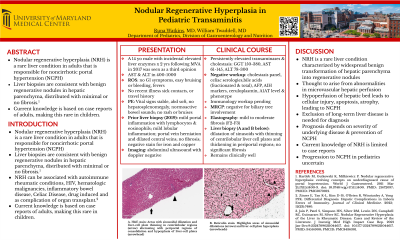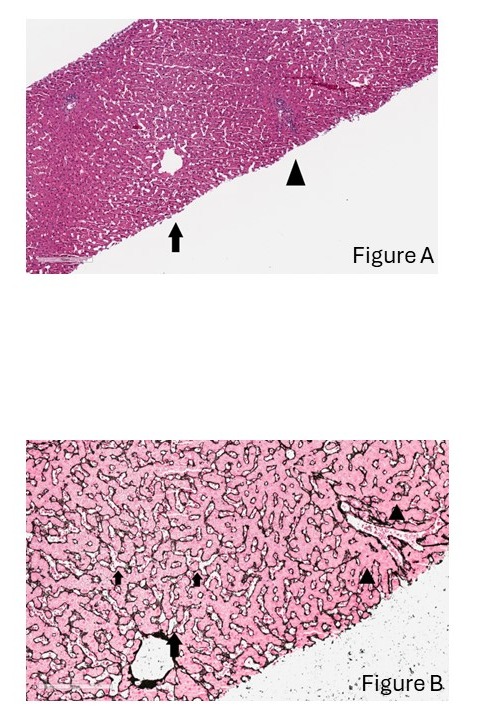Tuesday Poster Session
Category: Liver
P4699 - Nodular Regenerative Hyperplasia in Pediatric Transaminitis
Tuesday, October 29, 2024
10:30 AM - 4:00 PM ET
Location: Exhibit Hall E

Has Audio

Runa D. Watkins, MD
University of Maryland Medical Center
Baltimore, MD
Presenting Author(s)
Runa D. Watkins, MD, William Twaddell, MD
University of Maryland Medical Center, Baltimore, MD
Introduction: Nodular regenerative hyperplasia (NRH) is a rare liver condition in adults that is responsible for noncirrhotic portal hypertension (NCPH). Liver biopsies are consistent with benign regenerative nodules in hepatic parenchyma, distributed with minimal or no fibrosis.1 NRH can be associated with autoimmune rheumatic conditions, HIV, hematologic malignancies, inflammatory bowel disease, Celiac Disease, drug induced and as complication of organ transplant.2 Current knowledge is based on case reports of adults, making this rare in children.
Case Description/Methods: We describe a 14yo male with elevated liver enzymes following a motor vehicle accident. Enzymes remained elevated for 2 years, at which time an abdominal ultrasound was negative and liver biopsy showed nonspecific inflammation. Despite significant elevations of ALT and GGT, MRCP was normal. Patient started Ursodiol, which led to improvement in enzymes, but was discontinued. No further work up was performed until he sought another opinion 4 years later. Workup to evaluate for causes of transaminitis, including Wilson’s Disease, Autoimmune Hepatitis, Alpha 1 Antitrypsin Deficiency, Celiac Disease, and Viral Hepatitis (Hepatitis A/B/C; EBV, CMV), yielded negative results. Enzymes remained elevated and repeat biopsy showed dilated sinusoids, thinning of centrilobular liver cell plates, without fibrosis.
Discussion: NRH is a rare liver condition characterized by widespread benign transformation of hepatic parenchyma into regenerative nodules thought to arise from abnormalities in microvascular hepatic perfusion.1 Hypoperfusion within hepatic bed leads to cellular injury, apoptosis and atrophy, leading to development of NCPH.2 Exclusion of long-term liver disease is necessary for diagnosis. NRH can be asymptomatic, slow or non-progressive, unless complications of NCPH develop. While initial treatment is to address underlying disease, therapy is directed at management of NCPH. Prognosis depends on severity of underlying illness and prevention of secondary complications of NCPH. There are no published systematic population studies on NRH and current knowledge is limited to case reports.3 Due to small number of patients diagnosed, natural history and progression to NCPH is uncertain in pediatrics. In our case report, patient's work up is negative, and he does not have any risk factors. While we are currently unable to identify an etiology for biopsy findings, patient was referred to immunology and genetics teams for further investigations.

Disclosures:
Runa D. Watkins, MD, William Twaddell, MD. P4699 - Nodular Regenerative Hyperplasia in Pediatric Transaminitis, ACG 2024 Annual Scientific Meeting Abstracts. Philadelphia, PA: American College of Gastroenterology.
University of Maryland Medical Center, Baltimore, MD
Introduction: Nodular regenerative hyperplasia (NRH) is a rare liver condition in adults that is responsible for noncirrhotic portal hypertension (NCPH). Liver biopsies are consistent with benign regenerative nodules in hepatic parenchyma, distributed with minimal or no fibrosis.1 NRH can be associated with autoimmune rheumatic conditions, HIV, hematologic malignancies, inflammatory bowel disease, Celiac Disease, drug induced and as complication of organ transplant.2 Current knowledge is based on case reports of adults, making this rare in children.
Case Description/Methods: We describe a 14yo male with elevated liver enzymes following a motor vehicle accident. Enzymes remained elevated for 2 years, at which time an abdominal ultrasound was negative and liver biopsy showed nonspecific inflammation. Despite significant elevations of ALT and GGT, MRCP was normal. Patient started Ursodiol, which led to improvement in enzymes, but was discontinued. No further work up was performed until he sought another opinion 4 years later. Workup to evaluate for causes of transaminitis, including Wilson’s Disease, Autoimmune Hepatitis, Alpha 1 Antitrypsin Deficiency, Celiac Disease, and Viral Hepatitis (Hepatitis A/B/C; EBV, CMV), yielded negative results. Enzymes remained elevated and repeat biopsy showed dilated sinusoids, thinning of centrilobular liver cell plates, without fibrosis.
Discussion: NRH is a rare liver condition characterized by widespread benign transformation of hepatic parenchyma into regenerative nodules thought to arise from abnormalities in microvascular hepatic perfusion.1 Hypoperfusion within hepatic bed leads to cellular injury, apoptosis and atrophy, leading to development of NCPH.2 Exclusion of long-term liver disease is necessary for diagnosis. NRH can be asymptomatic, slow or non-progressive, unless complications of NCPH develop. While initial treatment is to address underlying disease, therapy is directed at management of NCPH. Prognosis depends on severity of underlying illness and prevention of secondary complications of NCPH. There are no published systematic population studies on NRH and current knowledge is limited to case reports.3 Due to small number of patients diagnosed, natural history and progression to NCPH is uncertain in pediatrics. In our case report, patient's work up is negative, and he does not have any risk factors. While we are currently unable to identify an etiology for biopsy findings, patient was referred to immunology and genetics teams for further investigations.

Figure: Figure A. H&E stain showing areas with sinusoidal dilatation and liver-cell plate thinning in centrilobular regions (arrow) alternating with periportal regions of consolidation and hyperplasia of liver-cell plates (arrowhead).
Figure B. Reticulin stain highlighting areas of sinusoidal dilatation (arrows) and liver-cell plate hyperplasia (arrowheads).
Figure B. Reticulin stain highlighting areas of sinusoidal dilatation (arrows) and liver-cell plate hyperplasia (arrowheads).
Disclosures:
Runa Watkins indicated no relevant financial relationships.
William Twaddell indicated no relevant financial relationships.
Runa D. Watkins, MD, William Twaddell, MD. P4699 - Nodular Regenerative Hyperplasia in Pediatric Transaminitis, ACG 2024 Annual Scientific Meeting Abstracts. Philadelphia, PA: American College of Gastroenterology.
